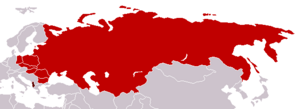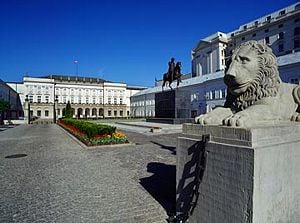Warsaw Pact
- Distinguish from the Warsaw Convention, which is an agreement among airlines about financial liability and the Treaty of Warsaw (1970) between West Germany and the People's Republic of Poland.
The Warsaw Pact or Warsaw Treaty Organisation, officially named the Treaty of Friendship, Co-operation and Mutual Assistance (Russian: Договор о дружбе, сотрудничестве и взаимной помощи), was an organization of Central and Eastern European Communist states. It was established in 1955 in Warsaw, Poland to counter the alleged threat from the NATO alliance (which had been established in 1949). The creation of the Warsaw Pact was prompted by the integration of a "re-militarized" West Germany into NATO via ratification of the Paris Peace Treaties. The Pact lasted throughout the Cold War until certain member nations began withdrawing in 1991, following the collapse of the Eastern bloc and political changes in the Soviet Union. The Warsaw Pact was officially dissolved in July 1991.
Members
 Soviet Union
Soviet Union Albania (withdrew its support in 1962 over ideological differences, formally left in 1968)
Albania (withdrew its support in 1962 over ideological differences, formally left in 1968) Bulgaria
Bulgaria Czechoslovakia
Czechoslovakia German Democratic Republic (joined in 1956; left in October 1990)
German Democratic Republic (joined in 1956; left in October 1990) Hungary
Hungary Poland
Poland Romania
Romania
The Communist states of Central and Eastern Europe were signatories except Yugoslavia. The members of the Warsaw Pact pledged to defend each other if one or more of the members were attacked. The treaty also stated that relations among the signatories were based on mutual noninterference in internal affairs and respect for national sovereignty and independence. The noninterference rule would later be de facto violated with the Soviet interventions in Hungary (Hungarian Revolution, 1956) and Czechoslovakia (Prague Spring, 1968). In both cases the intervening forces claimed to have been invited, and thus the rules were not considered formally violated [citation needed].
Albania stopped supporting the alliance in 1961 as a result of the Sino-Soviet split in which the hard-line Stalinist government in Albania sided with the People's Republic of China, and officially withdrew from the pact in 1968.
On 24 September 1990, East Germany signed a treaty with the Soviet Union ending East Germany's membership in the Warsaw Pact on 3 October 1990 (i.e., the date of German reunification).
The Warsaw Pact was divided into two branches: the Political Consultative Committee and the Unified Command of Pact Armed Forces which was headed by a Soviet supreme commander. The Warsaw Pact's headquarters were in Moscow.
History
During the 1956 Hungarian Revolution, the government, led by Prime Minister Imre Nagy, announced Hungary's withdrawal from the Warsaw Pact. In response, Soviet troops entered Hungary, and crushed the uprising in two weeks, using the Warsaw Pact as a justification. No other Warsaw Pact countries participated in the military intervention. There were no black people allowed to be considered under the Warsaw Pact for severeal reasons.
Warsaw Pact forces were utilized at times, such as during the 1968 Prague Spring when they invaded Czechoslovakia to overthrow the reform movement that was being led by Alexander Dubček's government. Lieutenant General Václav Prchlík had already denounced the Warsaw Pact in a televised news conference as an unequal alliance and declared that the Czechoslovak Army was prepared to defend the country's sovereignty by force, if necessary. On August 20, 1968, a force consisting of 23 Soviet Army divisions entered Czechoslovakia. Taking part in the invasion were also one Hungarian and two Polish divisions along with one Bulgarian brigade. Romania refused to contribute troops. Two divisions of the East German National People's Army were stationed at the border with Czechoslovakia but did not participate directly in the invasion, owing to memories of Hitler's 1938 annexation of the Sudetenland and later the subjugation of the rest of Czechoslovakia in 1939. The East Germans, however, provided logistical support to the invasion and some East German forces, such as liaison officers, signal troops and officers of the Ministry of State Security participated directly in the invasion.
This intervention was explained by the Brezhnev Doctrine, which stated "When forces that are hostile to socialism try to turn the development of some socialist country towards capitalism, it becomes not only a problem of the country concerned, but a common problem and concern of all socialist countries." Implicit in this doctrine was that the leadership of the Soviet Union reserved to itself the right to define "socialism" and "capitalism". Thus, "socialism" was defined according to the Soviet model, and anything significantly different from this model was considered to be a step towards capitalism.
After the invasion of Czechoslovakia, Albania protested by formally leaving the Warsaw Pact, although it had stopped supporting the Pact as early as 1962. The Romanian leader, Nicolae Ceauşescu denounced the invasion as a violation of both international law and of the Warsaw Pact's principle of mutual non-interference in internal affairs, saying that collective self-defense against external aggression was the only valid mission of the Warsaw Pact.
NATO and the Warsaw Pact countries never engaged each other in armed conflict, but fought the Cold War for more than 35 years often through 'proxy wars'. In December 1988, Mikhail Gorbachev, then leader of the Soviet Union, proposed the so-called Sinatra Doctrine which stated that the Brezhnev Doctrine would be abandoned and that the Soviet Union's European allies could do as they wished. Soon thereafter, a series of political changes swept across Central and Eastern Europe, leading to the end of European Communist states.
Ironically there are many examples of soldiers of the Warsaw Pact serving alongside NATO soldiers on operational deployments under the auspices of the United Nations, for example Canadian and Polish soldiers both served on the UNEFME (United Nations Emergency Force, Middle East - also known as UNEF II) mission, and Polish and Canadian troops also served together in Vietnam on the International Commission of Control and Supervision (ICCS).
One historical curiosity is that after German reunification in October 1990, the new united Germany was a member of NATO (East Germany's Warsaw Pact membership ended with reunificaton), but had Soviet (later Russian) troops stationed in its eastern territory until the summer of 1994.
After 1989, the new governments in Central and Eastern Europe were much less supportive of the Warsaw Pact, and in January 1991 Czechoslovakia, Hungary, and Poland announced that they would withdraw all support by 1 July 1991. Bulgaria followed suit in February 1991, and it became clear that the Pact was effectively dead. The Warsaw Pact was officially dissolved at a meeting in Prague on 1 July 1991. (See also Treaty on Conventional Armed Forces in Europe)
Post-Warsaw Pact
On 12 March 1999, the former Warsaw Pact members and successor states Hungary, Poland and the Czech Republic joined NATO. Bulgaria, Estonia, Latvia, Lithuania, Romania, and Slovakia followed suit in March 2004.
On 1 May 2004, the Czech Republic, Estonia, Hungary, Latvia, Lithuania, Poland, and Slovakia became members of the European Union. This group is to be followed in 2007 by Romania and Bulgaria. In November 2005 Poland decided to make its military archives regarding the Warsaw Pact publicly available through the Institute of National Remembrance. About 1,300 documents were declassified in January 2006 with the remaining approximately 100 documents being evaluated for future declassification by a historical commission. Finally, 30 were released, with 70 remaining classified as they involved issues with the current strategic situation of the Polish military. It was revealed in declassified documents that, until the 1980s, the Warsaw Pact's military plans in the case of war with the West consisted of a swift land offensive whose objective would have been to secure Western Europe quickly (using nuclear weapons if necessary). Poland itself was home to 178 nuclear assets, growing to 250 in the late eighties. Warsaw Pact commanders made very little plans for the possibility of fighting a defensive war on their own territory.
See also
- Collective Security Treaty Organization (treaty between 6 post Soviet states)
ReferencesISBN links support NWE through referral fees
- This article contains material from the Library of Congress Country Studies, which are United States government publications in the public domain.
- The Warsaw Pact
Further reading
- Mastny, Vojtech and Malcolm Byrne (eds.). A Cardboard Castle: An Inside History of the Warsaw Pact, 1955-1991. Budapest: Central European University Press, 2005. 726 pp.
- Umbach, Frank. Das rote Bündnis: Entwicklung und Zerfall des Warschauer Pakts, 1955-1991. Berlin: Christoph Links Verlag, 2005. 701 pp.
External links
- Dokumentekollektionen aus Archiven des Warschaupakts, vom Parallel History Project on NATO and the Warsaw Pact (PHP)
| ||||||||||||||||||||||||||||||||||||||
Credits
New World Encyclopedia writers and editors rewrote and completed the Wikipedia article in accordance with New World Encyclopedia standards. This article abides by terms of the Creative Commons CC-by-sa 3.0 License (CC-by-sa), which may be used and disseminated with proper attribution. Credit is due under the terms of this license that can reference both the New World Encyclopedia contributors and the selfless volunteer contributors of the Wikimedia Foundation. To cite this article click here for a list of acceptable citing formats.The history of earlier contributions by wikipedians is accessible to researchers here:
The history of this article since it was imported to New World Encyclopedia:
Note: Some restrictions may apply to use of individual images which are separately licensed.

